Although very much an exotic fruit, pomegranate trees take to the UK climate very well and can be grown successfully in garden environments. Originally from a region in modern-day Iran, pomegranates are one of the most ancient fruit types and are steeped in history. It is believed to be the fruit of death in Greek mythology and also has biblical links.
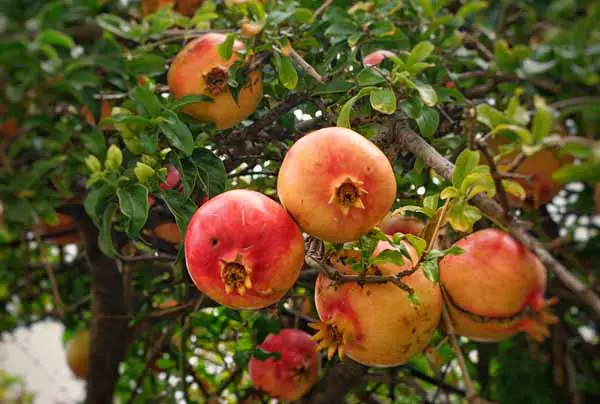
Pomegranate trees and plants have a spectacular array of scarlet, funnel-shaped flowers during the summer months. They belong to the deciduous shrub and can grow as high as 2.5 metres in roughly 10 to 20 years. Pomegranates taste great in salads, in guacamole, in cereal, yoghurts, in sangria, or as a sauce for meals. They have health benefits too – they can reduce the risk of heart disease, cancer, and arthritis.
Browse and compare fruit deals from top retailers without leaving our site!
Jump To...
Growing Pomegranate Trees in the UK
You might have thought growing an exotic fruit such as pomegranates would be tricky but it’s relatively easy. Most UK gardens will be fine for this type of plant or tree and our tips below should ensure you get a healthy fruit yield.
- Container-grown pomegranate plants might be handy so you can move yours indoors with ease when temperatures drop.
- They can be put outdoors once temperatures are warmer and all threats from frost have gone. Autumn temperatures of between 13 and 16 degrees celsius are ideal for fruit ripening.
- You can grow your plant in a greenhouse, a container, or in a polytunnel. They should be placed in a southwest direction with some shelter. You will get the best results buying sapling or cuttings but you can also grow from seed.
- Harvest in the autumn. This is best carried out using secateurs when the crown of the fruit has turned brown and started to curl.
- Light pruning should occur between spring and summer and this should involve removing any damaged or diseased shoots and branches. It is then recommended to mulch and feed your plant.
- If your pomegranate bush is wall-trained you will need to prune to maintain the shape and size you desire.
- During the spring and summer, you need to be watering your tree regularly – paying particular attention to hot days. You can also apply a plant feed monthly for extra nourishment. In winter your tree will not need much water.
- Pomegranates do best in loamy soil with plenty of drainage so they aren’t sitting in excess water.
- Most pomegranate plants and trees are self-pollinating so you only need one to get a decent fruit supply. This is good news if your space is on the smaller side, such as a patio or balcony.
About Pomegranates
Pomegranates are a deciduous shrub belonging to the Lythraceae family. They originate from Iran and northern India and grew in popularity across the Middle East, South Asia, and the Mediterranean.
They were one of the first fruit trees to be domesticated in the East Mediterranean, leading to the belief that they were domesticated as early as the fifth millennium BC.
It grew well anywhere with a warm and dry climate and was relied on for its thirst-quenching qualities. They have adapted well to cooler climates which can be seen here in the UK with their success rate. Pomegranates make a great addition to meals and are also popular for breakfasts and snacks.
Did You Know?
- Pomegranate means “apple with many seeds”.
- Pomegranate trees can live as long as 200 years in the right conditions.
- Pomegranates are mentioned in the Bible and also have links to Greek mythology.
- In Japan, they use pomegranates for bonsai.
Pomegranate FAQ’s
Pomegranates are a great fruit for healthy eating. Our FAQ’s section gives some snappy Q&A’s about this versatile UK garden fruit!
Pomegranate trees can reach a height of around 2.5 metres, dependant upon variety.
When your tree is two to three years old you can expect to see a healthy fruit yield.
You only need one pomegranate tree to produce a crop of fruit as they are self-pollinating.
Pomegranate trees are deciduous meaning they will lose their leaves in late Autumn and lie dormant over winter.

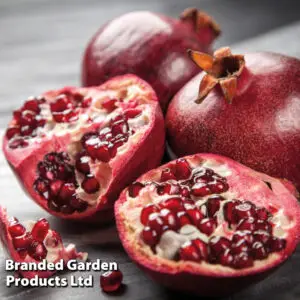

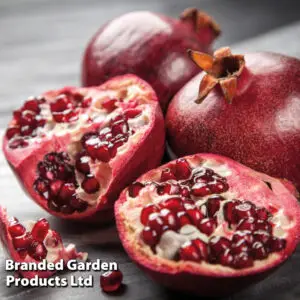
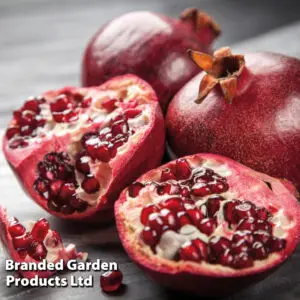

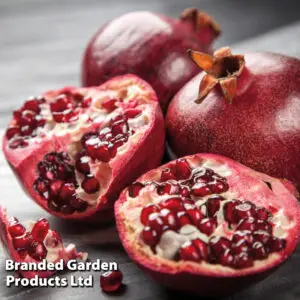

I live in the dales with a south facing garden it has a few fruit and berry trees around it, including a plum tree I’ve just found which is where I wanted to plant a pomegranate tree. Between the plum and some kind of old gnarly needly pine tree. Please could you let me know whether planting in the garden is not advisable. I don’t have a polytunnel or greenhouse and pots hate me.
Thank you.